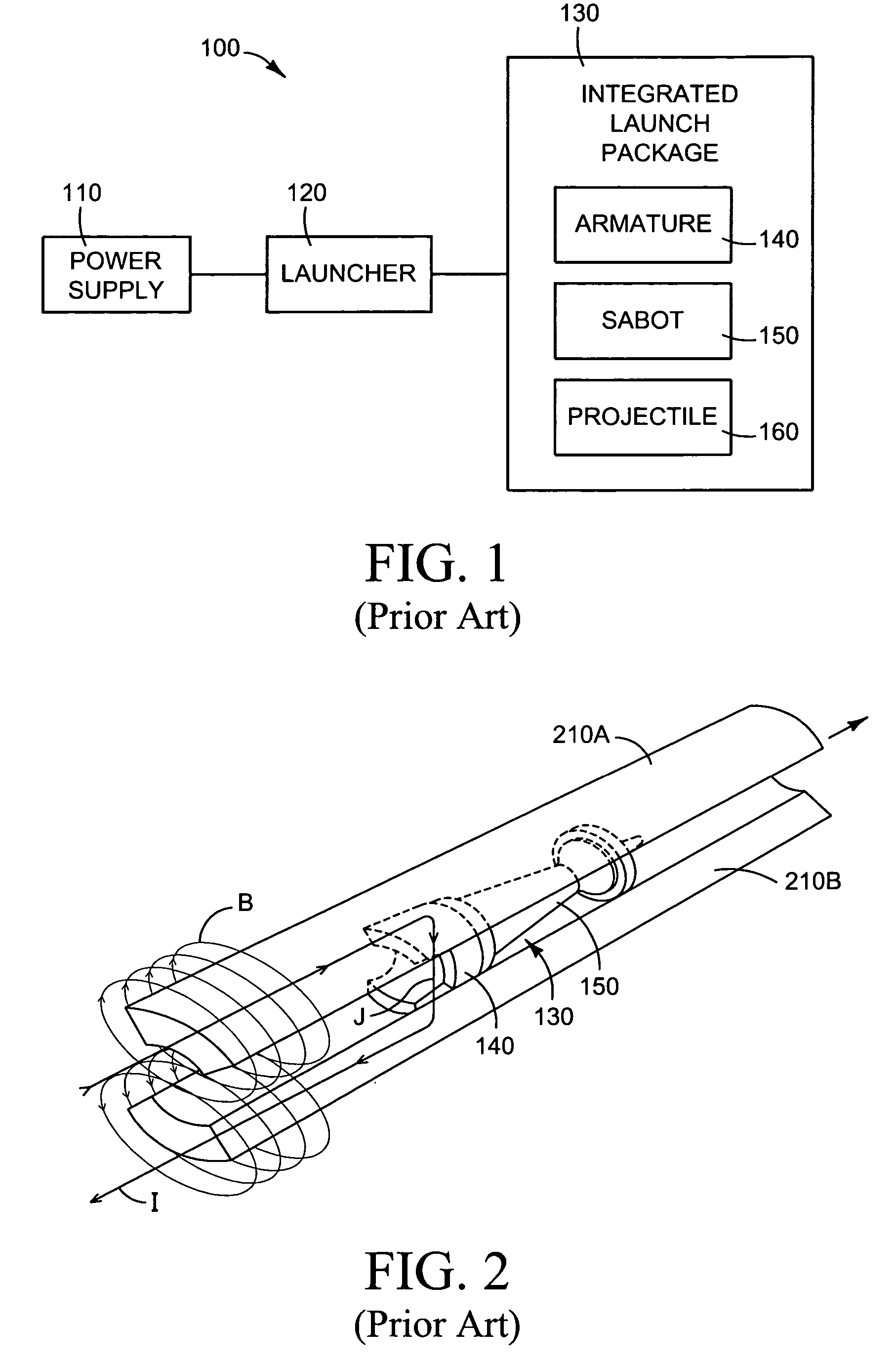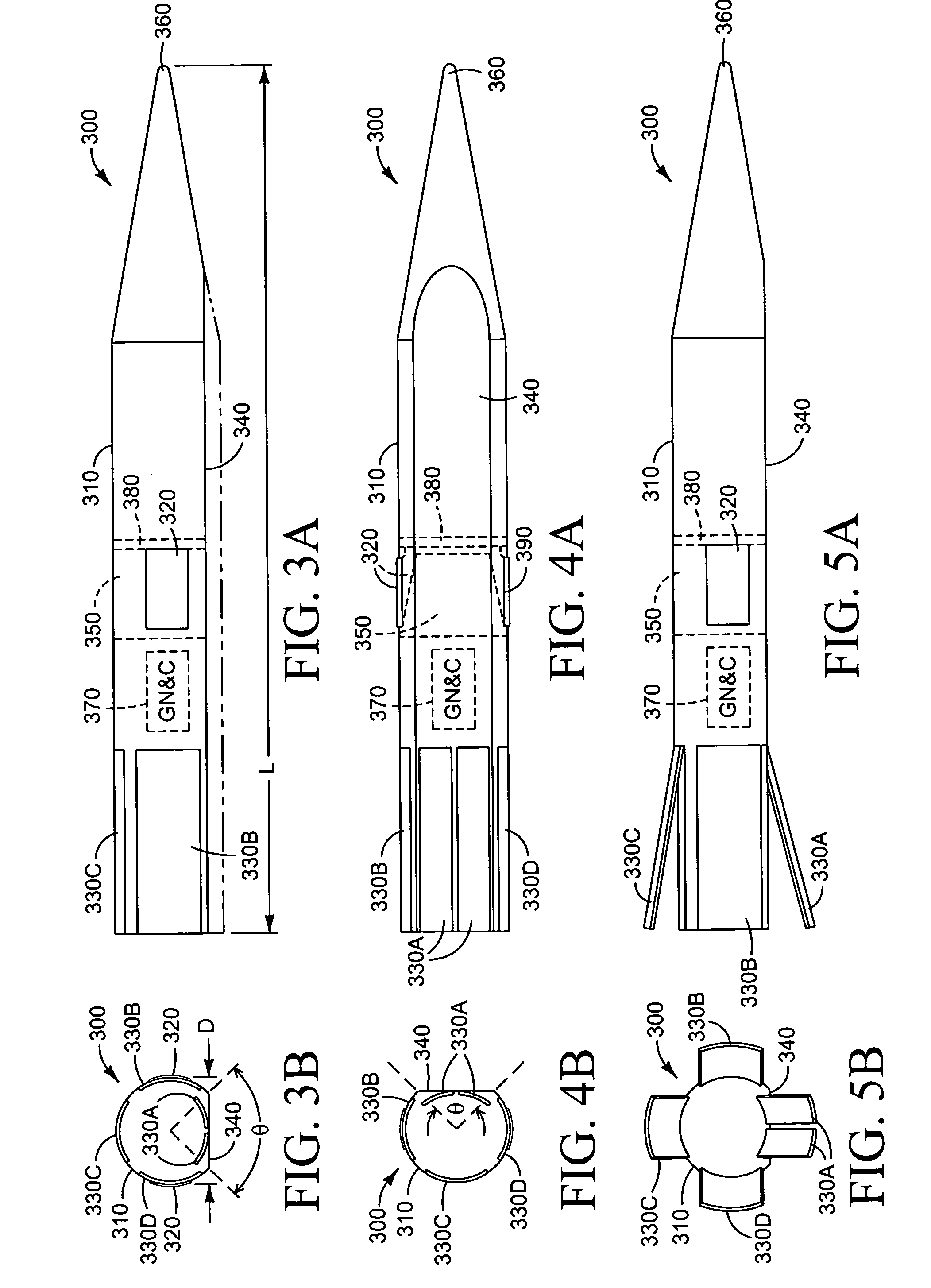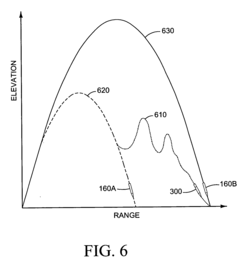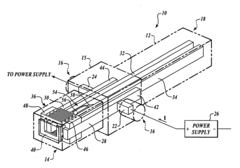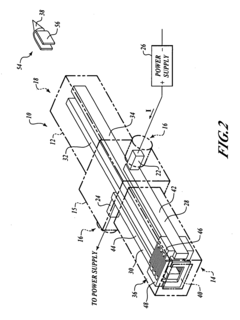Rail Gun Utilization for Low Earth Orbit Satellite Launch
AUG 6, 20259 MIN READ
Generate Your Research Report Instantly with AI Agent
Patsnap Eureka helps you evaluate technical feasibility & market potential.
Rail Gun Tech Evolution
The evolution of rail gun technology for satellite launch applications has seen significant advancements over the past few decades. Initially conceived as a military weapon, the rail gun's potential for space launch became apparent due to its ability to accelerate projectiles to extremely high velocities without the need for chemical propellants.
In the 1980s, early research focused on understanding the fundamental principles of electromagnetic acceleration and overcoming technical challenges such as power supply and rail erosion. The 1990s saw increased interest in rail guns for space applications, with NASA and other space agencies exploring their potential for launching small payloads into orbit.
The turn of the millennium marked a crucial phase in rail gun development. Improvements in power storage and switching technologies enabled the construction of more powerful and efficient rail gun systems. Researchers began to address key issues such as projectile design, thermal management, and rail durability, which were critical for adapting the technology to satellite launch applications.
By the 2010s, several research institutions and private companies had made significant strides in rail gun technology. Advanced materials, such as carbon nanotube-reinforced composites, were introduced to enhance rail durability and conductivity. Sophisticated power management systems and capacitor banks were developed to deliver the massive electrical currents required for launch.
Recent years have seen a shift towards practical implementation and scalability. Efforts have focused on increasing the size and power of rail gun systems to accommodate larger payloads, while simultaneously working to reduce system complexity and improve reliability. Integration with traditional rocket technology has also been explored, with concepts for hybrid launch systems that combine rail gun initial acceleration with chemical propulsion for orbital insertion.
The latest developments in rail gun technology for satellite launches include advancements in projectile aerodynamics to minimize atmospheric drag, innovative cooling systems to manage the extreme heat generated during launch, and the use of AI and machine learning algorithms to optimize launch parameters in real-time.
As we look towards the future, the rail gun's potential for revolutionizing satellite launches continues to drive innovation. Researchers are exploring novel concepts such as segmented rails for extended acceleration, superconducting materials for improved efficiency, and modular designs for rapid deployment and maintenance. These ongoing developments aim to make rail gun-based satellite launches more cost-effective, environmentally friendly, and capable of meeting the growing demand for frequent and flexible access to low Earth orbit.
In the 1980s, early research focused on understanding the fundamental principles of electromagnetic acceleration and overcoming technical challenges such as power supply and rail erosion. The 1990s saw increased interest in rail guns for space applications, with NASA and other space agencies exploring their potential for launching small payloads into orbit.
The turn of the millennium marked a crucial phase in rail gun development. Improvements in power storage and switching technologies enabled the construction of more powerful and efficient rail gun systems. Researchers began to address key issues such as projectile design, thermal management, and rail durability, which were critical for adapting the technology to satellite launch applications.
By the 2010s, several research institutions and private companies had made significant strides in rail gun technology. Advanced materials, such as carbon nanotube-reinforced composites, were introduced to enhance rail durability and conductivity. Sophisticated power management systems and capacitor banks were developed to deliver the massive electrical currents required for launch.
Recent years have seen a shift towards practical implementation and scalability. Efforts have focused on increasing the size and power of rail gun systems to accommodate larger payloads, while simultaneously working to reduce system complexity and improve reliability. Integration with traditional rocket technology has also been explored, with concepts for hybrid launch systems that combine rail gun initial acceleration with chemical propulsion for orbital insertion.
The latest developments in rail gun technology for satellite launches include advancements in projectile aerodynamics to minimize atmospheric drag, innovative cooling systems to manage the extreme heat generated during launch, and the use of AI and machine learning algorithms to optimize launch parameters in real-time.
As we look towards the future, the rail gun's potential for revolutionizing satellite launches continues to drive innovation. Researchers are exploring novel concepts such as segmented rails for extended acceleration, superconducting materials for improved efficiency, and modular designs for rapid deployment and maintenance. These ongoing developments aim to make rail gun-based satellite launches more cost-effective, environmentally friendly, and capable of meeting the growing demand for frequent and flexible access to low Earth orbit.
LEO Satellite Launch Demand
The demand for Low Earth Orbit (LEO) satellite launches has been experiencing significant growth in recent years, driven by various factors in the commercial, scientific, and defense sectors. This surge in demand is primarily fueled by the increasing need for global connectivity, Earth observation, and space-based services.
Commercial telecommunications companies are leading the charge in LEO satellite deployment, with ambitious plans to create vast constellations of satellites to provide global broadband internet coverage. These mega-constellations, consisting of hundreds or even thousands of satellites, aim to bridge the digital divide by offering high-speed internet access to remote and underserved areas worldwide.
Earth observation and remote sensing applications are also contributing to the rising demand for LEO satellite launches. Governments, research institutions, and private companies are leveraging satellite technology for environmental monitoring, disaster management, urban planning, and agriculture. The need for more frequent and higher-resolution imagery is driving the deployment of smaller, more cost-effective satellites in LEO.
The defense and security sector is another significant driver of LEO satellite launch demand. Military organizations are increasingly relying on satellite technology for communication, navigation, and intelligence gathering. The trend towards smaller, more agile satellites in LEO is enabling faster deployment and greater resilience in space-based defense systems.
The emergence of small satellite technology, particularly CubeSats and nanosatellites, has democratized access to space and further fueled the demand for LEO launches. These miniaturized satellites offer a more affordable and flexible option for universities, startups, and developing nations to participate in space exploration and research.
Market forecasts indicate a substantial growth trajectory for the LEO satellite launch market. Industry reports project the global small satellite market to reach values exceeding $10 billion by 2026, with a compound annual growth rate (CAGR) of over 20% during the forecast period. This growth is expected to translate directly into increased demand for launch services.
However, the current launch infrastructure is struggling to keep pace with the growing demand. Traditional rocket-based launch systems face limitations in terms of cost, frequency, and environmental impact. This gap between demand and launch capacity has created a pressing need for innovative launch technologies, such as rail gun systems, that can offer more frequent, cost-effective, and environmentally friendly access to LEO.
Commercial telecommunications companies are leading the charge in LEO satellite deployment, with ambitious plans to create vast constellations of satellites to provide global broadband internet coverage. These mega-constellations, consisting of hundreds or even thousands of satellites, aim to bridge the digital divide by offering high-speed internet access to remote and underserved areas worldwide.
Earth observation and remote sensing applications are also contributing to the rising demand for LEO satellite launches. Governments, research institutions, and private companies are leveraging satellite technology for environmental monitoring, disaster management, urban planning, and agriculture. The need for more frequent and higher-resolution imagery is driving the deployment of smaller, more cost-effective satellites in LEO.
The defense and security sector is another significant driver of LEO satellite launch demand. Military organizations are increasingly relying on satellite technology for communication, navigation, and intelligence gathering. The trend towards smaller, more agile satellites in LEO is enabling faster deployment and greater resilience in space-based defense systems.
The emergence of small satellite technology, particularly CubeSats and nanosatellites, has democratized access to space and further fueled the demand for LEO launches. These miniaturized satellites offer a more affordable and flexible option for universities, startups, and developing nations to participate in space exploration and research.
Market forecasts indicate a substantial growth trajectory for the LEO satellite launch market. Industry reports project the global small satellite market to reach values exceeding $10 billion by 2026, with a compound annual growth rate (CAGR) of over 20% during the forecast period. This growth is expected to translate directly into increased demand for launch services.
However, the current launch infrastructure is struggling to keep pace with the growing demand. Traditional rocket-based launch systems face limitations in terms of cost, frequency, and environmental impact. This gap between demand and launch capacity has created a pressing need for innovative launch technologies, such as rail gun systems, that can offer more frequent, cost-effective, and environmentally friendly access to LEO.
Rail Gun Launch Challenges
The utilization of rail guns for launching satellites into Low Earth Orbit (LEO) presents several significant challenges that must be addressed before this technology can be considered viable. One of the primary obstacles is the extreme acceleration forces experienced during launch. Rail guns can accelerate projectiles to velocities exceeding 2,500 meters per second, subjecting the payload to forces of up to 10,000 g. This level of acceleration poses a severe risk to sensitive satellite components and electronics, necessitating the development of robust packaging and shock-absorption systems.
Another critical challenge is the atmospheric drag encountered during the initial launch phase. As the projectile exits the rail gun at hypersonic speeds, it experiences intense friction and heating due to air resistance. This can lead to significant thermal stress on the satellite and its protective casing, potentially causing damage or altering the trajectory. Addressing this issue requires advanced materials and aerodynamic designs capable of withstanding extreme temperatures and maintaining structural integrity.
The precision and accuracy of rail gun launches also present formidable challenges. Achieving the exact velocity and trajectory required for LEO insertion demands exceptional control over the launch parameters. Even minor deviations in the initial launch conditions can result in substantial orbital errors, potentially rendering the satellite unusable or requiring costly corrective maneuvers. This necessitates the development of highly sophisticated guidance and control systems integrated into both the rail gun and the satellite payload.
Power requirements for rail gun launches are another significant hurdle. The electromagnetic forces needed to accelerate a satellite-carrying projectile to orbital velocities demand enormous amounts of electrical energy delivered in a very short time frame. This requires advanced power storage and delivery systems, as well as infrastructure capable of handling such high-energy discharges repeatedly and reliably.
The environmental impact of rail gun launches must also be considered. The electromagnetic pulse generated during launch can potentially interfere with nearby electronic systems, while the sonic boom produced by the hypersonic projectile may cause disturbances in surrounding areas. Mitigating these effects requires careful site selection and the implementation of protective measures.
Lastly, the transition from rail gun launch to orbital insertion presents unique challenges. Unlike traditional rocket launches, which can make course corrections during ascent, rail gun-launched satellites must rely on precise initial conditions and potentially small onboard propulsion systems for final orbital adjustments. Developing efficient and reliable methods for this transition is crucial for the success of rail gun-based satellite launches.
Another critical challenge is the atmospheric drag encountered during the initial launch phase. As the projectile exits the rail gun at hypersonic speeds, it experiences intense friction and heating due to air resistance. This can lead to significant thermal stress on the satellite and its protective casing, potentially causing damage or altering the trajectory. Addressing this issue requires advanced materials and aerodynamic designs capable of withstanding extreme temperatures and maintaining structural integrity.
The precision and accuracy of rail gun launches also present formidable challenges. Achieving the exact velocity and trajectory required for LEO insertion demands exceptional control over the launch parameters. Even minor deviations in the initial launch conditions can result in substantial orbital errors, potentially rendering the satellite unusable or requiring costly corrective maneuvers. This necessitates the development of highly sophisticated guidance and control systems integrated into both the rail gun and the satellite payload.
Power requirements for rail gun launches are another significant hurdle. The electromagnetic forces needed to accelerate a satellite-carrying projectile to orbital velocities demand enormous amounts of electrical energy delivered in a very short time frame. This requires advanced power storage and delivery systems, as well as infrastructure capable of handling such high-energy discharges repeatedly and reliably.
The environmental impact of rail gun launches must also be considered. The electromagnetic pulse generated during launch can potentially interfere with nearby electronic systems, while the sonic boom produced by the hypersonic projectile may cause disturbances in surrounding areas. Mitigating these effects requires careful site selection and the implementation of protective measures.
Lastly, the transition from rail gun launch to orbital insertion presents unique challenges. Unlike traditional rocket launches, which can make course corrections during ascent, rail gun-launched satellites must rely on precise initial conditions and potentially small onboard propulsion systems for final orbital adjustments. Developing efficient and reliable methods for this transition is crucial for the success of rail gun-based satellite launches.
Current Rail Gun Solutions
01 Electromagnetic rail gun design and power systems
Rail guns use electromagnetic forces to launch projectiles at high velocities. Key aspects include the design of electromagnetic coils, power supply systems, and energy storage mechanisms to generate the required magnetic fields for projectile acceleration.- Electromagnetic rail gun design and power systems: Rail guns utilize electromagnetic forces to launch projectiles at high velocities. Key aspects include the design of electromagnetic rails, power supply systems, and energy storage mechanisms to generate the intense magnetic fields required for projectile acceleration.
- Projectile design and materials for rail gun applications: Specialized projectiles are crucial for rail gun performance. This includes the development of materials and designs that can withstand the extreme forces and temperatures experienced during launch, as well as optimizing projectile shape for improved aerodynamics and range.
- Rail gun launch control and guidance systems: Advanced control and guidance systems are essential for accurate rail gun launches. This involves the integration of sensors, computer systems, and algorithms to manage the launch sequence, adjust for environmental factors, and guide the projectile to its target.
- Thermal management and cooling systems for rail guns: Effective thermal management is critical for rail gun operation due to the intense heat generated during launches. This includes the development of cooling systems for the rails, power components, and other critical elements to maintain performance and extend operational lifespan.
- Rail gun integration and mounting systems: Integrating rail guns into various platforms, such as ships or land-based systems, requires specialized mounting and stabilization systems. This includes designs for recoil management, platform integration, and ensuring structural integrity during high-energy launches.
02 Projectile design and materials for rail gun applications
Specialized projectiles are crucial for rail gun performance. This includes the development of materials and shapes that can withstand the extreme forces and temperatures during launch, as well as maintain stability and accuracy in flight.Expand Specific Solutions03 Rail gun launch control and guidance systems
Advanced control and guidance systems are essential for accurate targeting and trajectory management of rail gun projectiles. This involves the integration of sensors, computer systems, and algorithms for real-time adjustments during launch and flight.Expand Specific Solutions04 Thermal management and cooling systems for rail guns
Efficient thermal management is critical for rail gun operation due to the extreme heat generated during launch. This includes the development of cooling systems and heat-resistant materials to maintain operational integrity and extend the lifespan of rail gun components.Expand Specific Solutions05 Rail gun integration with existing weapon platforms
Adapting rail gun technology for integration with various military platforms, such as ships, ground vehicles, or fixed installations. This involves addressing size, weight, and power constraints, as well as developing interfaces for existing combat systems.Expand Specific Solutions
Key Rail Gun Players
The rail gun utilization for low Earth orbit satellite launch is in an early development stage, with a relatively small but growing market. The technology's maturity is still low, requiring significant research and investment. Key players like Lockheed Martin, Northrop Grumman, and Boeing are exploring this technology, leveraging their aerospace expertise. Universities such as Caltech and Beihang University are contributing to fundamental research. The involvement of defense-oriented companies like Rafael Advanced Defense Systems and MBDA UK suggests potential dual-use applications. While promising, the technology faces challenges in scaling and practical implementation for commercial satellite launches.
The Boeing Co.
Technical Solution: Boeing has developed a large-scale electromagnetic launch system for satellites, leveraging their extensive experience in aerospace engineering. Their rail gun design incorporates a segmented rail system that allows for controlled acceleration profiles, reducing stress on the payload[12]. Boeing's approach includes a sophisticated projectile design with a protective aeroshell that doubles as a heat shield for atmospheric reentry, enabling potential recovery and reuse of the launch vehicle[13]. The company has also implemented advanced power management systems, including the use of flywheel energy storage to handle the pulsed power demands of the rail gun. Boeing's launch system is designed to be mobile, allowing for flexible launch locations and potentially enabling sea-based launches for improved equatorial access[14].
Strengths: Controlled acceleration profiles suitable for a wide range of payloads; Potential for recoverable and reusable launch vehicles. Weaknesses: Large-scale system requires significant infrastructure; High development and operational costs.
Lockheed Martin Corp.
Technical Solution: Lockheed Martin has developed an advanced electromagnetic rail gun system for satellite launch applications. Their design utilizes a series of electromagnetic coils to accelerate a projectile carrying a small satellite to hypersonic speeds[1]. The system can achieve muzzle velocities of up to 7.5 km/s, significantly reducing the amount of propellant needed to reach orbit[2]. Lockheed's rail gun incorporates a sophisticated power management system to handle the massive electrical currents required, along with thermal management technologies to dissipate heat generated during launch[3]. The company has also developed specialized projectiles designed to protect the satellite payload from the extreme g-forces experienced during acceleration.
Strengths: High launch velocity reduces propellant needs; Reusable launch system with quick turnaround times. Weaknesses: High power requirements; Limited payload size due to projectile constraints.
Rail Gun Core Innovations
Electromagnetic railgun projectile
PatentInactiveUS20070261543A1
Innovation
- The design includes an aeroshell with an integrated armature near the center-of-gravity and extendable flaps, allowing for increased lethality mass delivery and reduced armature transition by optimizing the aerodynamic lifting surface and flap control during flight.
Electromagnetic launcher with augmenting breech
PatentActiveUS20080053299A1
Innovation
- The design includes a slidable electromagnetic launcher housing with augmentation conductors and main conductors connected via a current cross-over connection, allowing for recoil accommodation while maintaining electrical contact, and reducing overall inductance by limiting augmentation to early stages of the launch cycle, which facilitates faster current rise and balanced weight distribution.
Environmental Impact
The environmental impact of utilizing rail guns for low Earth orbit satellite launches is a critical consideration in the development and implementation of this technology. While rail guns offer potential advantages in terms of reduced reliance on chemical propellants, their environmental footprint requires careful examination.
One of the primary environmental benefits of rail gun technology is the significant reduction in chemical emissions compared to traditional rocket launches. Conventional rockets release large amounts of carbon dioxide, water vapor, and other pollutants into the atmosphere, contributing to climate change and air pollution. Rail guns, powered by electricity, can potentially minimize these emissions, especially if the electricity is sourced from renewable energy.
However, the environmental impact of rail gun launches extends beyond emissions. The intense electromagnetic fields generated during launch may have localized effects on wildlife and ecosystems in the immediate vicinity of the launch site. Studies are needed to assess the potential impact on migratory birds, marine life, and local fauna, particularly in terms of disruption to navigation and breeding patterns.
The acoustic impact of rail gun launches is another environmental concern. While potentially less severe than traditional rocket launches, the sonic boom and high-frequency noise generated by hypersonic projectiles could still affect local communities and wildlife. Mitigation strategies, such as strategic placement of launch sites and sound-dampening technologies, may be necessary to minimize these effects.
Land use and habitat disruption are additional factors to consider. Rail gun facilities require substantial infrastructure, including power generation and distribution systems, which could lead to habitat fragmentation or loss. Careful site selection and environmental impact assessments are crucial to minimize these effects and ensure compliance with conservation regulations.
The production and disposal of rail gun components also warrant environmental scrutiny. While the technology may reduce the need for chemical propellants, it relies heavily on advanced materials and electronics. The lifecycle analysis of these components, from raw material extraction to end-of-life disposal, must be conducted to ensure that the overall environmental footprint is indeed smaller than that of conventional launch systems.
Lastly, the potential for space debris generation must be addressed. While rail guns offer precise launch capabilities, any malfunction or miscalculation could result in projectiles or payloads becoming orbital debris. Strategies for minimizing this risk and ensuring responsible space utilization are essential components of the environmental considerations for rail gun satellite launch technology.
One of the primary environmental benefits of rail gun technology is the significant reduction in chemical emissions compared to traditional rocket launches. Conventional rockets release large amounts of carbon dioxide, water vapor, and other pollutants into the atmosphere, contributing to climate change and air pollution. Rail guns, powered by electricity, can potentially minimize these emissions, especially if the electricity is sourced from renewable energy.
However, the environmental impact of rail gun launches extends beyond emissions. The intense electromagnetic fields generated during launch may have localized effects on wildlife and ecosystems in the immediate vicinity of the launch site. Studies are needed to assess the potential impact on migratory birds, marine life, and local fauna, particularly in terms of disruption to navigation and breeding patterns.
The acoustic impact of rail gun launches is another environmental concern. While potentially less severe than traditional rocket launches, the sonic boom and high-frequency noise generated by hypersonic projectiles could still affect local communities and wildlife. Mitigation strategies, such as strategic placement of launch sites and sound-dampening technologies, may be necessary to minimize these effects.
Land use and habitat disruption are additional factors to consider. Rail gun facilities require substantial infrastructure, including power generation and distribution systems, which could lead to habitat fragmentation or loss. Careful site selection and environmental impact assessments are crucial to minimize these effects and ensure compliance with conservation regulations.
The production and disposal of rail gun components also warrant environmental scrutiny. While the technology may reduce the need for chemical propellants, it relies heavily on advanced materials and electronics. The lifecycle analysis of these components, from raw material extraction to end-of-life disposal, must be conducted to ensure that the overall environmental footprint is indeed smaller than that of conventional launch systems.
Lastly, the potential for space debris generation must be addressed. While rail guns offer precise launch capabilities, any malfunction or miscalculation could result in projectiles or payloads becoming orbital debris. Strategies for minimizing this risk and ensuring responsible space utilization are essential components of the environmental considerations for rail gun satellite launch technology.
Space Law Implications
The utilization of rail guns for low Earth orbit satellite launches raises significant space law implications that must be carefully considered. The Outer Space Treaty of 1967, which forms the foundation of international space law, emphasizes the peaceful use of outer space and prohibits the placement of weapons of mass destruction in orbit. While rail guns are not explicitly mentioned in the treaty, their potential dual-use nature as both a launch system and a weapon could raise legal concerns.
One key issue is the classification of rail guns under existing space law frameworks. As a non-rocket launch technology, rail guns may fall into a regulatory gray area. This ambiguity could lead to challenges in obtaining launch licenses and international recognition of launches conducted using rail gun technology. Additionally, the high-velocity projectiles used in rail gun launches could be perceived as potential weapons, potentially violating the spirit, if not the letter, of international space law agreements.
The use of rail guns for satellite launches also raises questions about liability and responsibility. The Liability Convention of 1972 establishes rules for damage caused by space objects, but it may not adequately address the unique risks associated with rail gun launches. The high-speed nature of rail gun projectiles could potentially increase the risk of collisions with other space objects or debris, necessitating new legal frameworks to address these specific concerns.
Furthermore, the environmental impact of rail gun launches must be considered from a legal perspective. While rail guns may offer reduced environmental impact compared to traditional rocket launches, the potential for atmospheric disturbances or electromagnetic interference could raise regulatory concerns. National and international environmental laws may need to be updated to specifically address the unique characteristics of rail gun launch systems.
The militarization of space is another critical legal consideration. While rail guns for satellite launches are intended for civilian purposes, the technology's potential military applications could lead to increased scrutiny and potential restrictions under international law. This dual-use nature may require careful negotiation and clear delineation between civilian and military applications to ensure compliance with existing space treaties and avoid escalating tensions in the international community.
In conclusion, the use of rail guns for low Earth orbit satellite launches presents a complex set of legal challenges that intersect with existing space law, environmental regulations, and international security agreements. As this technology advances, it will be crucial for policymakers, legal experts, and space agencies to work together to develop clear, comprehensive legal frameworks that address these unique challenges while promoting responsible and peaceful space exploration.
One key issue is the classification of rail guns under existing space law frameworks. As a non-rocket launch technology, rail guns may fall into a regulatory gray area. This ambiguity could lead to challenges in obtaining launch licenses and international recognition of launches conducted using rail gun technology. Additionally, the high-velocity projectiles used in rail gun launches could be perceived as potential weapons, potentially violating the spirit, if not the letter, of international space law agreements.
The use of rail guns for satellite launches also raises questions about liability and responsibility. The Liability Convention of 1972 establishes rules for damage caused by space objects, but it may not adequately address the unique risks associated with rail gun launches. The high-speed nature of rail gun projectiles could potentially increase the risk of collisions with other space objects or debris, necessitating new legal frameworks to address these specific concerns.
Furthermore, the environmental impact of rail gun launches must be considered from a legal perspective. While rail guns may offer reduced environmental impact compared to traditional rocket launches, the potential for atmospheric disturbances or electromagnetic interference could raise regulatory concerns. National and international environmental laws may need to be updated to specifically address the unique characteristics of rail gun launch systems.
The militarization of space is another critical legal consideration. While rail guns for satellite launches are intended for civilian purposes, the technology's potential military applications could lead to increased scrutiny and potential restrictions under international law. This dual-use nature may require careful negotiation and clear delineation between civilian and military applications to ensure compliance with existing space treaties and avoid escalating tensions in the international community.
In conclusion, the use of rail guns for low Earth orbit satellite launches presents a complex set of legal challenges that intersect with existing space law, environmental regulations, and international security agreements. As this technology advances, it will be crucial for policymakers, legal experts, and space agencies to work together to develop clear, comprehensive legal frameworks that address these unique challenges while promoting responsible and peaceful space exploration.
Unlock deeper insights with Patsnap Eureka Quick Research — get a full tech report to explore trends and direct your research. Try now!
Generate Your Research Report Instantly with AI Agent
Supercharge your innovation with Patsnap Eureka AI Agent Platform!

